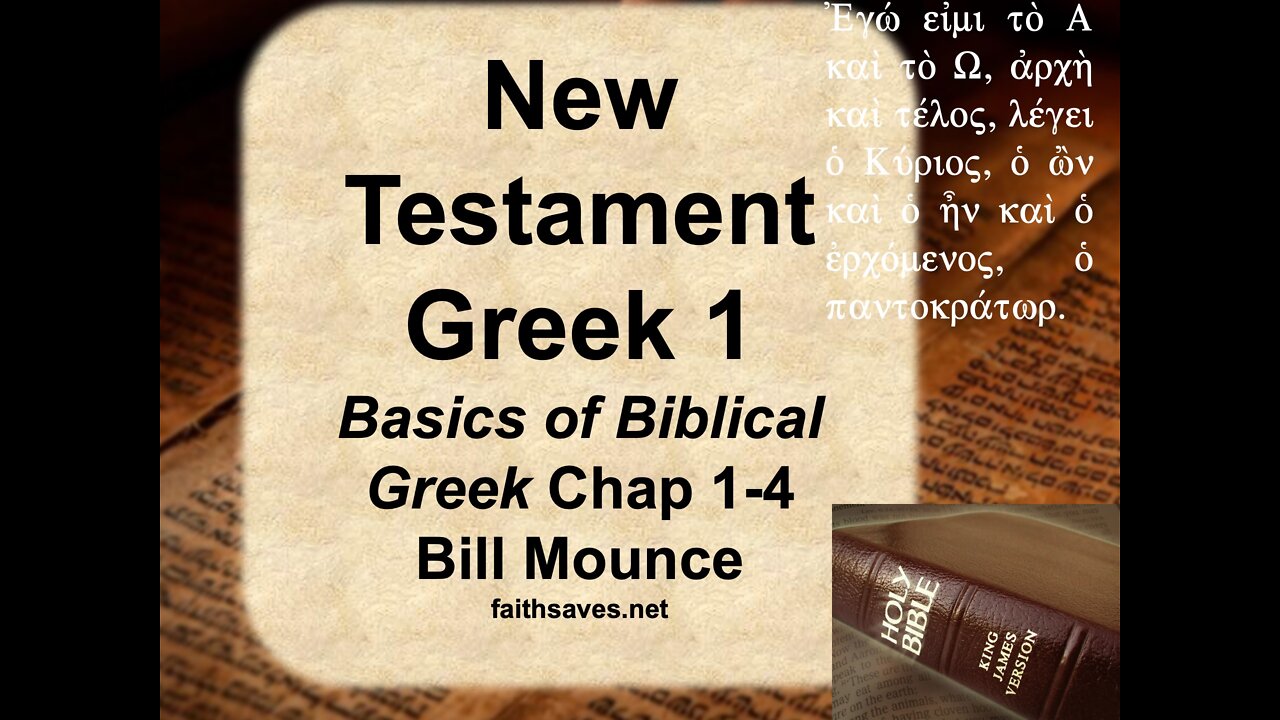Premium Only Content

New Testament / Koine Greek, 1st year, Lect #1: Intro & Basics of Biblical Greek, Mounce, Chap. 1-4
Lecture #1 in New Testament or Koine Greek; first year Greek at a college or seminary level taught by independent Baptist professor Thomas Ross, utilizing WIlliam (Bill) Mounce, Basics of Biblical Greek, and other texts.
Learn more about the class at:
https://faithsaves.net/Greek-courses/
Textbooks include William Mounce, Basics of Biblical Greek Grammar; Bill Mounce, Basics of Biblical Greek Workbook; the Greek Textus Receptus or Received Text; T. Michael Halcomb, Speak Koine Greek: A Conversational Phrasebook & 800 Words and Images: a New Testament Greek Vocabulary Builder. Recommended texts include Frederick W. Danker, A Greek-English Lexicon of the New Testament and other Early Christian Literature, 3rd. ed. (BDAG) & William D. Mounce, The Morphology of Biblical Greek.
The New Testament is approached from a Bible-believing perspective as the perfectly inspired and preserved Word of God.
Lecture #1 covers Basics of Biblical Greek chapters 1-4, including the Greek alphabet with its consonants, vowels, diphthongs, pronunciation, and syllabification, as well as the vocabulary for those chapters. The first chapter covers a basic overview of the history of the Greek language explains the transition from classical to Koine or common Greek. What college and seminary students need to memorize, and the importance of time, consistency, and discipline, comes under discussion in chapter two. Chapter three covers how to write and pronounce the alphabet, with its consonants, vowels, and diphthongs, and the rough and smooth breath marks that appear on words beginning with a vowel. The letters of the Greek alphabet are:
Alpha ἄλφα a Α α
Beta βῆτα b Β β
Gamma γάμμα g Γ γ
Delta δέλτα d Δ δ
Epsilon ἒψιλόν e Ε ε
Zeta ζῆτα z Ζ ζ
Eta ἦτα ē Η η
Theta θῆτα th Θ θ
Iota ἰῶτα i Ι ι
Kappa κάππα k Κ κ
Lambda λάμβδα l Λ λ
Mu μῦ m Μ μ
Nu νῦ n Ν ν
Xi ξῖ x Ξ ξ
Omicron ὂ μικρόν o Ο ο
Pi πῖ p Π π
Rho ῥῶ r Ρ ρ
Sigma σίγμα s Σ σ/ς
Tau ταῦ t Τ τ
Upsilon ὖ ψιλόν u/y Υ υ
Phi φῖ ph Φ φ
Chi χῖ ch Χ χ
Psi ψῖ ps Ψ ψ
Omega ὦ μέγα ō Ω ω
The Greek vowels are α, ε, η, ι, ο, υ, and ω. The rough breath mark is a ῥ placed over the first vowel. Words that begin with rho and upsilon always have a rough breath mark. The smooth breath mark appears like a ἀ over an initial vowel and is not pronounced.The Greek diphthongs are αι, ει, οι, αυ, ου, υι, ευ & ηυ. Iota subscript is a small iota written under three vowels: ᾳ, ῃ, ῳ.
Chapter four covers rules for Greek syllabification-the division of syllables, as well as punctuation and accent marks. The Greek , means a comma in Greek. The . is a period. The · means a semicolon, and the Greek ; is a question mark. Greek apostrophe and elision is covered. The Greek acute accent specifies a rise in pitch that the pitchon the accented syllable (BBG example: αἰτέω).
The Greek grave accent specifies a drop in pitch on the accented syllable (BBG example: καὶ). The circumflex accent specifies that one's voice rises and then drops slightly on the accented syllable (BBG example: ἁγνῶς). Accents assist with pronunciation, memorization, and the identification of certain words. The acute ( ´) can occur on any of the last three syllables. The circumflex (ῶ) can occur only on one of the last two syllables and will always be over a long vowel.The grave (ὶ) is formed when a word is normally accented with an acute on the final syllable. When not followed by a punctuation mark, a word's acute accent becomes a grave. Accents on nouns try to stay on the same syllable-consistent accent. Accents on verbs move as close to the beginning of the verb as possible-recessive accent.
Greek syllabification is very similar to English syllabification. The basic rules are:
1.) There is one vowel (or diphthong) per syllable.
2.) A single consonant by itself goes with the following vowel.
3.) Two consecutive vowels that do not form a diphthong are divided.
4.) A consonant cluster that can not be pronounced together is divided, and the first consonant goes with the preceding vowel.
5.) A consonant cluster that can be pronounced together goes with the following vowel.
6.) Double consonants are divided.
7.) Compound words are divided where joined.
William Mounce's Basics of Biblical Greek assigns fewer vocabulary words than many other grammars, because the 319 words assigned cover approximately 80% of the word usage in the New Testament. Dr. Ross supplements the vocabulary in Bill Mounce's grammar with words from Halcomb. Students will learn not only to understand, exegete, and translate the New Testament but also to converse in Greek.
The FaithSaves website's section on college courses contains course syllabi, handouts, and other important material for taking this course.
-
 DVR
DVR
Redacted News
7 hours agoWhat's REALLY going on in Syria? | Redacted with Natali Morris
138K65 -
 54:18
54:18
Candace Show Podcast
7 hours agoHarvey Speaks: Jessica Mann & The Five Year Affair | Ep 3
138K37 -
 56:53
56:53
Grant Stinchfield
6 hours ago $5.38 earnedFreeze Spending & Kick the Can Down the Road... Why Republicans Should do Just That!
69.2K10 -
 56:48
56:48
VSiNLive
6 hours agoFollow the Money with Mitch Moss & Pauly Howard | Hour 1
58.1K -
 3:28:27
3:28:27
Barry Cunningham
8 hours agoTRUMP DAILY BRIEFING: INTERNET UNDER ATTACK! X & RUMBLE DOWN! EXECUTIVE ORDER SIGNING!
81.3K40 -
 5:53:56
5:53:56
Scammer Payback
11 hours agoCalling Scammers Live
71.3K5 -
 1:36:15
1:36:15
In The Litter Box w/ Jewels & Catturd
1 day agoABOLISH NGOs | In the Litter Box w/ Jewels & Catturd – Ep. 758 – 3/10/2025
92.5K58 -
 2:04:36
2:04:36
Film Threat
1 day agoVERSUS: DAREDEVIL: BORN AGAIN + MICKEY 17 + THE STATE OF SCI-FI | Film Threat Versus
40.7K -
 1:21:46
1:21:46
The HotSeat
8 hours agoIt's A Trap America! Do Not Fall For It!
30.9K19 -
 1:26:22
1:26:22
The Quartering
9 hours agoTrump In Dubai, Democrats BUSTED Funding Attacks On Tesla, DOGE Covid BOMBSHELL & Bernie Sanders
88.9K79